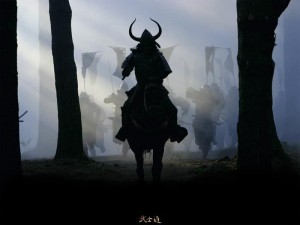A code of Samurai, Japanese chivalry (3) 2015/06/07
A code of Samurai was strongly influenced by Buddhism, Confucianism and Shintoism and finally reached the refined and sublimated stage after the 700 years long journey. There were many textbooks for Samurai during 700 years Samurai’s times. First one was ( Goseibai shikimoku), as earlier mentioned, which introduced 51 articles to be kept by Samurai.
( Kouyou gunkan) and ( Hagakure) were published in Edo era and both are famous and typical Samurai textbooks.
The contents of books which reflected values and standards of each time changed as time went on and a code of Samurai or Samurai’s way of thinking also changed as time went on.
During the age of civil wars (1467-1590), Samurai had to survive and he had to be strong and smart enough to survive through disturbance of wars. He had to be talented to obtain credibility both from his boss and from his servants.
At that time, Samurai had frequent opportunities to be promoted by making military achievements during wars.
Meantime a famous warlord, Toudou Takatora left the word that Samurai should change his lord at least 7 times. It means Samurai should try and select the right lord.
On the contrary, Edo era (1603-1867) was the time of peace. There were no more civil wars and Samurai did neither have any opportunity to show a military achievement, nor an opportunity to select his lord.
It became most important for Samurai to serve to his lord as loyal as possible and they said as their lesson that Samurai should not serve to any other lord than present lord.








